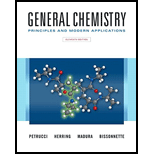
(a)
Interpretation:
The nucleophile that reacts faster with
Concept introduction:
The nucleophilic substitution reaction
Nucleophiles are the electron-rich species that donate the electron pair to the electron-deficient species in the reaction. The electron-deficient species are known as the electrophiles.
(b)
Interpretation:
The substrate that reacts faster with
Concept introduction:
The nucleophilic substitution reaction
Want to see the full answer?
Check out a sample textbook solution
Chapter 27 Solutions
Generl Chem Looself&mod Mst/et&stdy Crd Pkg, 11/e
- a. Compound X is benzene, Y is acetic anhydride acid. Complete the following scheme and determine Z! b. Determine which reagents except acetic acid anhydrides can replace Y!arrow_forwardPleas explain how this process occurs. Identify SN1, SN2, E2, E1, nucleophiles and electrophiles.arrow_forwardPredict the order of reactivity (1 being the slowest, 3 being the fastest) of primary, secondary, and tertiary alkyl halides toward nucleophilic displacement by an SN1 reaction mechanismarrow_forward
- Rank the following compounds in order of their reaction rates in an SN1 reaction with HOCH3 with 1 being the fastest reaction and 4 being the slowestarrow_forward2- Mention the product of a nucleophilic substitution reaction of (S)-2-bromohexane with acetate ion, CH3CO2- Assume that inversion of configuration occurs, and show the chemistry of both the reactant and product. 3- Draw the mechanism of the SN2 Reaction. Show the correct directions of the arrows, and all reagents. 4- Draw the mechanism of the SN1 Reaction. Show the correct directions of the arrows, and all reagents. 5- Draw the mechanism of the E2 Reaction with an Alkyl Halide. Show the correct directions of the arrows, and all reagents. 6- Draw the mechanism of the E1 Reaction with an Alkyl Halide. Show the correct directions of the arrows, and all reagents. 7- Mention the product formed in an SN2 reaction between 1-bromobutane and NaI. 8- Rank the following compounds in order of their expected reactivity toward SN2 reaction: CH3Br, CH3OTos, (CH3)2CHCl. 9- Explain Grignard Reagents in details with one example. 10- Mention how a halogen substituent can be replaced by a deuterium atom…arrow_forwardProvide the mechanism for the following transformation. D = 2Harrow_forward
- The preparation of cyclohexene from cyclohexanol follows which mechanism? (A) SN2 (B) SN1 (C) E2 (D) E1arrow_forward5. Propose a plausible mechanism for the following transformation:arrow_forwardProvide a reasonable arrow-pushing mechanism for Reaction 5b, and explain the the stereochemical outcome. 5d belowarrow_forward
- Draw the four resonance structures formed during bromination of methoxybenzene, CH3OC6H5, with Br2/FeBr3 to give para-bromomethoxybenzene and then circle the most stable resonance form.arrow_forwardWhen a cyclic ketone reacts with diazomethane, the next larger cyclic ketone is formed. This is called a ring-expansion reaction. Draw a mechanism for the following ring-expansion reaction.arrow_forwardGive the following reaction A+3B --->2C.arrow_forward
